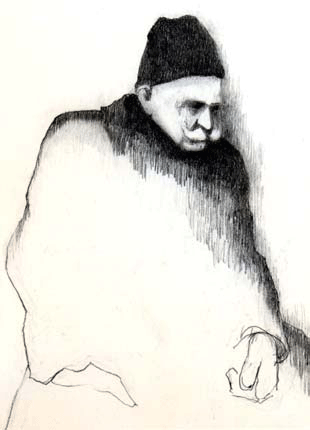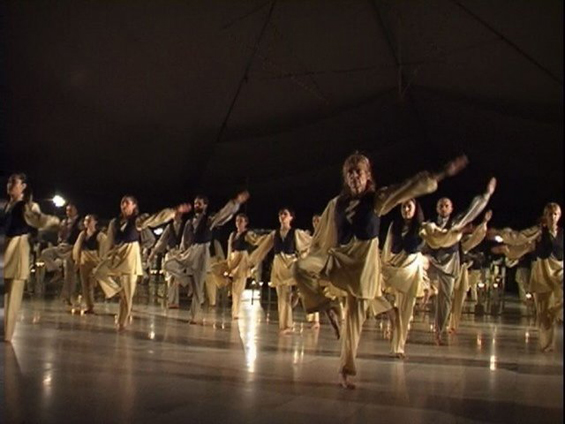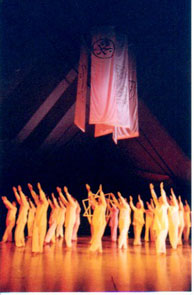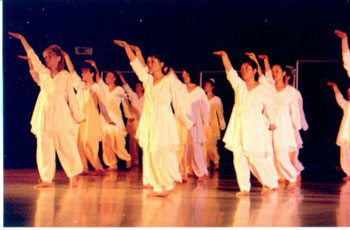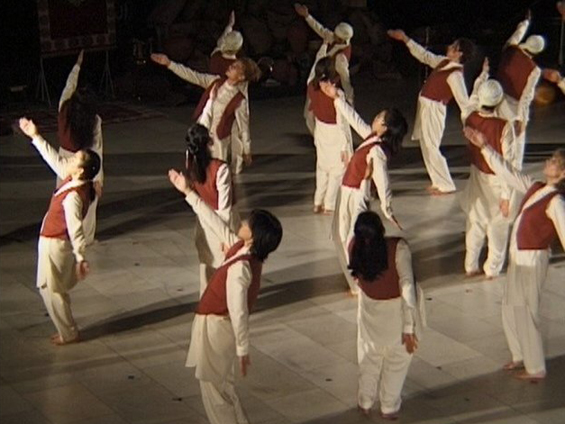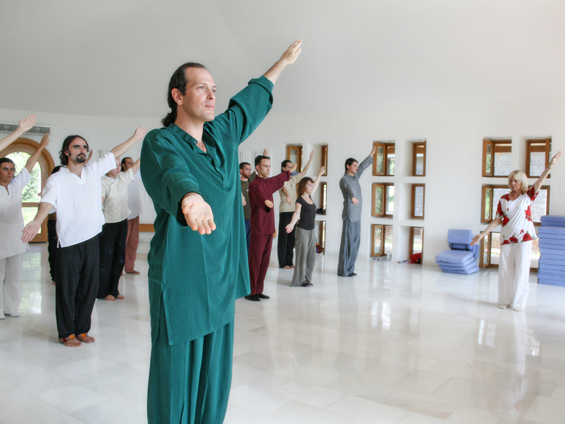Movements and Sacred Dances of Gurdjieff, a way to Self-realization
Amiyo Devienne, Master of Sacred Dances and movement of Gurdjieff
Amiyo Devienne, dancer and choreographer, dance teacher and dance therapist. Trained in several psycho-corporal techniques, in Esalen Institute (USA), in African dance in Douala (Cameroon), in contemporary dance in France, Amiyo Devienne studied Gurdjieff movements with Avrom Altmann, direct student of John G. Bennett, and with Deborah Rose and James Tomarelli also students from the Bennett-lineage.
She offer an unique synthesis through her view about East-West dance. For 30 years now, she travels worldwide, sharing her experiences on movement, as a science, as an art, as a tool for inner –development. In September she with Chetan Greenberg will offer a special 3 week movements training in Lalita Devi (Cáceres).
Jordtsal Wu – February 2015
-What are the Movements and Sacred Dances of Gurdjieff and who was this man?
Gurdjieff was a mystic, spiritual master who was born in 1866 in the Caucasus at the border between Russia and Turkey. From childhood he was under the influence of many cultures and religions criss-crossing through this area, coming from the East and the West. He was very young and had a very open mind; these different influences of course stimulated even more his curiosity about the mystery of human existence. So at the age of twenty he started to travel with a group of people that called themselves ‘The Seekers of Truth’, in search of the meaning of human existence. For twenty years, he went on a search in Egypt, in Central Asia, in Tibet, in India, in the Gobi Desert, in Afghanistan, in Uzbekistan, and he discovered that some of the wisdom coming from ancient traditions were transmitted through music and dance. So he visited monasteries, temples, esoteric schools and gathered a core of about 250 sacred Movements and music taught in these places. They became an important part of his Teaching. When he came back twenty years later to Russia he devoted his life to share what he had found in these different countries and also what he had discovered in his own experience. The movements are just a fragment of Gurdjieff’s teaching that is very vast and that he kept developing them along his life. He died in 1949 in Paris.
-You have spent your whole life searching your Self through different techniques of dances. How did you know Gurdjieff’s Work, his movements and Sacred performances?
I was in Osho Community from 1978 until 2002 in Pune. And so I heard about Gurdjieff first through Osho, because Osho mentions him a lot in his discourses. Then Osho asked me to become dance therapist as part of a crew of therapists in the Multiversity of Pune. This was in 1979 and I started leading dance theater group there. Then in 1989 he called me in, showed the VHS of the film ‘Meeting with remarkable men’ directed by Peter Brook and Madame de Salzmann. He said that there was nothing extraordinary about this movie except the last 10 minutes. The last 10 minutes are showing the movements. He asked me to ‘Look at these movements, study them, find their key and once you are found the key report to me.’ So I went home and for three days and two nights non-stop I looked at the movements. Trying to decipher them was not easy because in that time you could not slowdown the speed. So I kept on winding and rewinding the tape, on and on …Then, I knew nothing about the logic behind those movements but eventually I understood the choreography. I still remember my first very strong reaction when I saw these movements. I got goose pimples and was just inhabited by one question: ”what is this?” The Movements seem to be the echo of a deep longing in me… I was always looking for the meeting between stillness and movement in my carriere as a dancer and it seems that there, was the answer. I reported to Osho what I have understood and how the sequences work in these movements. Osho asked me to start immediately to teach these movements in my groups. That was the beginning of leading the Gurdjieff Movement groups in Pune.
-How do you consider the movements as any special kind of art? Because Gurdjieff mentions and make difference between Objective art and Subjective art, and introduced the concept of Legominism. Can you talk about this?
Yes, we can consider these Movements as an expression of Objective art. They are created by an enlightened Being, and for Gurdjieff they are not subject to emotionality, sentimentalism or fashion, they are not born from a personal point of view. They are beyond fashion, they are beyond personality. Objective art expresses cosmic laws that have the same effect on everybody. Subjective art actually for example in dance is often an expression of personality of the choreographer and the personality of the dancers. With these movements Gurdjieff was not interested into enhancing the personality, but much more into the individuality of every dancer. The personality is a mask created by the society; the individuality is born from our essence.
The movements nourish our essence, they are not meant to serve our Ego. At first it seems like everybody does the same but actually every dancer is strongly responsible and has very specific role in his position, in his sequence, in his displacement and has to apply a balanced attention between himself and the world around him. Gurdjieff used to say that the movements are not an art, they are a science, and they are an Objective science. Gurdjieff wanted a certain effect to be manifested through the Movements and he based his work on the science of archetypes: for example the archetype of compassion, or courage, Gratitude, or peace, or joy, or nostalgia. He created the movements with this idea to embody a certain archetype on earth. This effect happens of course in the dancer himself but also happens on the public watching the dance. So in that sense it’s an Objective science. The Movements are at the service of consciousness, not at the service of ego and personality. Gurdjieff was very, very attentive, precise when he created the movements, they didn’t come like this in one day. He would try something then would feel, see, sense the effect on the group of dancers, and then would transform and again transform, sometimes for three weeks until he was satisfied with the effect he was looking for. And sometimes, he would drop the Movement all together.
-Yes, one have impression about the existence of true mathematics of movement, because all is very exact, the movements quite precise and synchronized…
Yes, yes it is more a science than an art. Gurdjieff investigated the science of movement which is also connected with the science of vibrations. For him everything is vibrations. Music is vibration, movement is vibration, the sound of your voice is vibration, feelings are vibrations, the movements of the planets are vibrations…
-People can ask themselves why these kinds of dances are called sacred, Sacred Dances?
The movements have different goals. One is the most obvious: they are very powerful tool to help us becoming conscious about our selves and the world around us. So self-awareness and also self- remembering. There is a difference. The first step is self-awareness or self-observation, which means: I am observing my arm, I am observing my emotion, I am observing the music, I have an object of observation, the observer and the observed are different. The arrow of attention is directed towards the object of observation. And then the second step is when your awareness involves both, the object that you see and yourself as the seer. When this double arrow is practiced, one arrow towards the outside, one arrow towards the inside. So I am listening to music and at the same time I am aware of the listener, I am performing the movements, I see my body, this position in the space and at the same time I am aware of myself watching the movement. That is self-remembering and that is most important point in Gurdjieff’s Work.
The second goal of the movements is that they illustrate the symbols of universal Laws that are governing the whole universe. The two major laws Gurdjieff is referring to are the Law of Three and the Law of Seven. Which you find in many traditions and religions, such as in the symbol called the Enneagram. The expression of these movement, of planets, the movement of emotions, of physiological movements.., on all levels from Microcosmos to Macrocosmos, they are governed by the same Laws. That is the second point.
Another goal is the transformation of energies. Everything is energy, everything is movement. There are many different kinds of forces or energies around us. To which energy am I open? I can be open to the lower energies of greed, fear, anger, hate, of comparison , competition… I can be also open to higher forces: of compassion, outer-consideration, Love and Kindness, and so on. And there are also spiritual forces: emptiness, serenity, peace. So inside of us we are constantly under the influence of different forces. The movements create conditions, create an opportunity so that we have the possibility to open up as an antenna to higher forces. We have the possibility to open to the higher forces of energy but for this our 3 centers: physical, emotional, intellectual have to be united, have to be aligned.
-The music for these Movements and dances were of Gurdjieff but the score was arranged for piano solo and orchestrated too by one of his most important students: Thomas de Hartmann. This sounds really strange. Can you explain it? How happened this special collaboration for so notable creative work?
There is a real collaboration between Thomas de Hartmann and Gurdjieff. Gurdjieff when traveling around, he was hearing different musics in temples, in monasteries. He remembered them later on, so when he came back to the West and started to share his discoveries, he would sing the melody or play with one finger . Th. de Hartmann which was an accomplished musician then made all the arrangements and created a piece, for piano or for orchestra. Gurdjieff himself was sometimes playing guitar, harmonium, so he had some musical bases but the person who really created from the base given by Gurdjieff, was Th. de Hartmann. Because he had the skills of a musician, of a composer, which Gurdjieff did not have. Gurdjieff knew which effect he wanted. They worked intensively together on the music from 1927 to 1929 and created more than 300 pieces of music. Many music pieces have been created by T. de Hartmann without Gurdjieff and later on by Alain Kremski or Michael Edwards. So it is not all Gurdjieff’s music but most of the movements are practiced on Gurdjieff’s music.
-You lived many years in India, as you said you lived in the International Commune of Osho. How it was your learning there and your relation with the master? How it was, because you began with the performances there, right?
This was Osho’s guidance, it was not my idea. As I told you at first I was there working with dance theater which was my basic profession. I was trained, as a dancer and choreographer and dance therapist. I started to work as dance therapist. Then Osho, (for what I am very grateful), asked me to go more in the direction of Gurdjieff movements . We were having seminars of five to six weeks with the same people, Osho asked: ‘Each group should finish with a performance’
It’s a very strong opportunity to have an experience of centering and distance from emotions because of course when you stand in front of so many people there are a lot of emotions moving inside and the point is not to be taken by these emotions but to stay solidly grounded, centered. To see the emotions because we can not repress them but to choose to put our attention for ex. in our breathing, or in the soles of the feet, or in the music, in our body moving, to sense the support we receive from the force field of the group. The subject of performance is a direct guidance from Osho.
-Osho developed a kind of integrated work combining different sources and spiritual traditions, but his teaching and method were really his own creative work. In some aspects one can think that Gurdjieff and Osho were both kinds of chief cooks offering their own kitchen recipes… Don’t you think so?
Gurdjieff has a very specific teaching, which he developed from his encounters with different traditions and experience .Osho used also many different teachings. His whole approach is very vast because he wanted to touch as many people as possible. Some people are more intellectual oriented so he had some teaching for them, some people are more emotional so had some teaching for them, some people are more physical and he had some teaching for them. So when I was in Pune we were offered many different therapies, many different meditations, Buddhist meditation, Sufi camp, Taoist approach,… Osho was taking the essence of many different spiritual paths, taking the best of them . Gurdjieff also was strongly influenced by Christian Orthodoxy, Sufism, Tibetan Buddhism, Taoism,…So both of them actually took from the essence of different spiritualities to create a teaching that could benefit the modern man.
-In the teaching of Fourth Way, there is an important concept: The Work. What is the Work of Gurdjieff? What is the meaning of Work?
Gurdjieff says that we are robots, that we are sleep, and that most of what we are doing is done on automatic, so again we come back to this idea of force. We are under the force of automatism most of the time. So Gurdjieff’s work functions like an alarm clock ‘ Wake up, Wake up, Wake up…’ Because alone you can not wake up, Gurdjieff deviced group Work : exercises , methods, situations and movements, so we can not fall in mechanicity, into automatic, unconscious behaviors, automatism in our gestures,…For example eating my soup, I am not consciously eating my soup, I am probably thinking on what I am going to do immediately after the meal. I am not present to eating, but I eat automatically, as I don’t need consciousness to pick my spoon and put it in my mouth. The same way with emotional automatism : I always react the same way towards someone: my boyfriend says something to me and I am reacting .It’s so fast that I am not behind it, I am taken by the force of the emotion before I can even realize it. There is also automatism in the mind. Our mind is constantly automatically associating, one idea followed by another followed by another. Constantly the mind is absorbed into some associations. Gurdjieff called this mind the Formatory Apparatus, an automatic way of thinking, automatic believe systems, narrow mindedness, prejudice…We see this in this period in the world where there is so much intolerance, so much fanaticism: all conditioned and automatic ways of thinking. It is not consciously owned by the person, it has been brought into this mind by the surrounding, by the culture, by the religion by the country. So the Work of Gurdjieff is to wake up from automatic energy and enter more into a conscious life.
-Returning to the movements, The practice of movements reflect how we realize and relate with ourselves, with other people and with the world, right? That is very beautiful, no?
Of course because our attention is called in both directions: one is on oneself and one is on the world around us. So, this is the difficulty, how to have an attention that can include in a balanced way myself and the others. Usually we are taken by the world outside, we are taken by an event, we are taken by the weather: the weather is bad, so we feel bad, we feel depressed, we are taken by the look someone gives us, positive or negative. Freedom comes when we stop being taken away automatically by what happens on the outside and also on the inside: A bad digestion and I am in a bad mood.
The other direction of attention is a movement going to the source inside ourselves. So, it is difficult because we live in these two realities: We live in the inner world and we live in the outer world. How to include in a balanced way in our awareness these two worlds? This is a big part of the Work of Gurdjieff and so, also of the movements.
-Gurdjieff tells ‘the man have three centers: Intellectual, Emotional and Physical’. So is necessary harmonize them developing the three kind of attention. Can you tell how is worked this process of harmonization through dance and movements?
At first sight, you would think that the movements are mostly including the body, the physical center but in fact there is also the demand of a very strong involvement of the mind and the heart. The mind: because the movements are not symmetrical; often they are a combination of strange and unusual sequences, or different rhythms, the arms moving in sequences of three counts while the legs are moving on four counts for example. So you have to see both elements at the same time, your mind is occupied with this task .Sometimes, Gurdjieff asks us to make a certain counting while we move, or to repeat words, or to move one sequence later than the neighbor we have on the right. All of this keeps our mind occupied, but occupied in relation with the body, in the same moment as the body. This way, we connect the body and the mind. Often our body and mind are not connected at all. Our mind has some demands that he wants the body to follow, the body doesn’t care, the body really doesn’t care!. And the heart doesn’t have much interest in it. So often our three centers are not working together. I may be brushing my teeth, physically I am brushing my teeth but my heart is heavy or concerned because I just had a fight with my boyfriend, and my mind is planning what I will do after finishing brushing my teeth .
The movements bring the three centers on the same spot, in this very moment and if possible with the same force. The body, the mind and the heart are involved with the same force. How is the heart involved? The heart comes when body and mind are connected. Then there is a feeling, the feeling of being present, the feeling of “I Am”. Also we can open our sensitivity to the music, the music triggers some feeling or emotion .It can be connected with the fact that we are moving together as group, towards the same goal which is consciousness or just an effect of having our mind and our body connected. So, one of the first steps in the practice is to connect body and mind through attention. What we call sensing the body, not just seeing the body in a mirror. We don’t use mirror, we rather sense the body from inside, the attention makes a direct contact with the body, with the music, with the rhythm, with the ground, with physical reality, and then a feeling comes. The three centers are united.
-So talking about mind and no-mind, at last when the three centers are integrated, is then Is possible experience no-mind, right?
Ok, takes a little time! But yes, yes it is true. When our three centers are aligned then comes he experience of Presence in its purity and clarity. It may then happen that suddenly the movement is done through you. But this is after lot of practice, first you practice, you repeat and repeat and repeat, and eventually comes a moment when there is something like a movement within the movement, a presence within presence, the outer movement happens and you realize that you are not the doer, it is been done through you, the movement is the active force which takes your body, you are just like a empty and open receptacle. You are just like an antenna, you are just like a void, emptiness, and through that void the wind of the movement blows and it’s manifested on the outside through you. But you are more on a receptive mode than on an active mode. The first line of the Work is very active, you have first to make efforts, to understand, to remember, to sense, to feel the movement and suddenly comes a moment when maybe for a split second you see:” Wahhhh, I am not the doer, it’s happening in me!”. Comes a moment also when this thought is not even there, when the mind is absolutely quiet. For this, my body needs to be relaxed, my heart needs to be peaceful and open. ‘I have practiced and integrated the movements, I am here, I am present.’Then may come this moment of blessings when there is no mind, there is just this action, this movement now, and ‘I am not Amiyo or Jordtsal, I am the movement, I disappear in the movement.’ You can have sometimes a glimpse of this experience in free dance also when you totally let go in your dance and you dance so totally that you are no more a person, you are pure movement of energy and this is really delightful.
-So, it seems this practice of Gurdjieff movements creates exceptional conditions for transform the body-machine, breaking our automatic patterns, and allowing a higher awareness and consciousness…
Yes, this is what I was saying to you in the beginning. Through the movement we see. We see by and by, the transformation of energy from automatic to more and more conscious and sensitive .It happens progressively. It is not like an instant coffee, this is not Mc Donald. It takes time, it takes patience, and it takes also trust. We go through difficulties: Some movements are easy but some are challenging. This is when we have to remember why we are doing this. What helped me tremendously was my trust in Osho, which is my master. Osho is the one who told me to develop the teaching of the Gurdjieff Movements in his Commune, and then in the world. So I felt carried by the force of the Master. In period of challenges trust is important: To remember that these are not just dances, they have been created by an enlightened master and we have seen ourselves in our life, again and again, the benefits that the practice of the movements brings in our daily life. This helps.
-You had created and directed many public dance demonstrations, whose 30 were of Gurdjieff Movements. At the moment you are teaching intensively around the world, about training people through workshops or very special intensives seminars. Can you say about it?
Actually at the moment we are also preparing a public presentation of the Movements that will happen in Munich at the end of March 2015, with a group of students from Munich, Japan, Ukraine, Italy, France etc…. We are since about one and half year practicing and deepening the same movements. Personally, I am not really in favor of organizing this type of event. “Performance” could so easily be an enhancing of the ego!. Ego is so quickly there, taking the whole credit! But it’s my part of own work, as a facilitator, to bring our awareness on this point. The question remains: At the service of whom am I? Am I at the service of my ego? Or am I at the service of something higher that could be manifested and offered to the individual, the group and the public?
I am more interested by the transmission of the Movements to a regular group of students, without having this goal of a presentation.
Chetan, my partner and I we are traveling a lot around the world, not just only in India now, but also in Germany, in Spain, in Russia, in Denmark, in Italy, in Belgium, in France, in Japan, South Korea, USA. So far, yes, we are moving a lot.
-Yeh, yes, many countries eh?
Yes, it’s interesting because you see that the teaching is different according to the country. Of course, the core of the teaching remains the same; there is no place for compromising it. But the way to transmit is different according to the people we have in front of us, this is where our creativity is active. The teaching is different in India than in Japan because the collective personality of Indian is very different than collective personality of Japanese. For example in Japan, people tend to be very disciplined, but also tense, so the work will be oriented more towards relaxation and self acceptance. In India, we have a very different situation. The work may be into bringing more attention to the body, because many Indian are not very connected with the body. And we would also help them understand the meaning of discipline .The question is always:”Whom do I have in front of me?”So this makes our work very interesting, and creative!.
-That is really very rich for you, no?
Yeh, this is my luck! I started this work in Pune, which was an international Community with many, many different nationalities, so I had international access and made friends from many countries of the world and that is the reason why we go so easily from one country to another, because we are invited there.
-Did you studied with students of John G. Bennet, right?
Yes. When Osho asked me to lead movements groups in Pune, in 1989 he just pushed me into the swimming pool before I could even swim! But I also received the support I badly needed In the multiversity of Pune, where I worked , the chancellor, named Prasad helped me a lot; He had been before part of a Bennett community, or Gurdjieff community( I am not sure which), in England. Prasad was my first mentor and guided me when I started.
After Osho’s death, we then started to spread out in the world .One day, I was buying a book of Gurdjieff in a bookshop and inside this book, there was a little leaflet advertizing a seminar of Gurdjieff Movements in Santa Fe, New Mexico, USA. And this was the first time really that the Movements were taught to a larger public, outside The Gurdjieff Foundation. Until then, they just had been taught within the Gurdjieff Foundation, very, very privately. And suddenly a group of three teachers were offering seminars in Santa Fe! Of course, I immediately bought my flight ticket and I went for few years working with them. I specially feel grateful towards Avrom Altmann, and with whom I learned a lot, technically, and also humanly. When Avrom decided to stop teaching the movements to involve himself with the teaching of psychology, in University, he gave me his movements notes, saying:” Make good use of these notes”.
Later on, I met Dushka, the daughter of Gurdjieff. Through her also I was guided. I went several times in New York to be with her. Three years ago, I received through Internet all the notes she had gathered on movements and music: She had died and she wanted all her notes to be available to teachers and musicians. So like this, Existence keeps on giving me support, through meetings, through material documents, to study deeper, to understand better and too evolve in my practice in my teaching and in my life, in spite of many oppositional forces. I have received very strong support from existence and can only be grateful towards the life that has been given to me.
Thank you very much for share so much with us. DLX – February 2015

